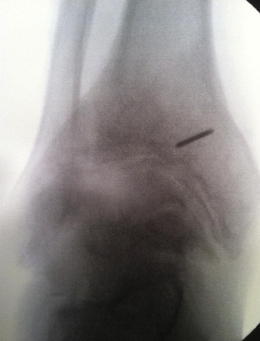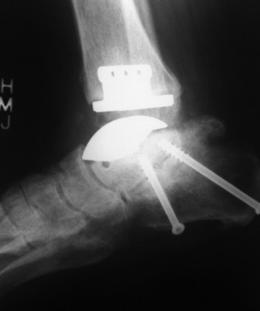Tibiotalocalcaneal Arthrodesis
Keywords
• Tibiotalocalcaneal arthrodesis (TTCA) • Ankle arthrodesis • Subtalar arthrodesis • Pantalar arthrodesis • Ankle arthrosis • Subtalar arthrosis • Charcot arthropathy • Limb salvage
Introduction
This author’s personal patient care experience with tibiotalocalcaneal arthrodesis (TTCA) has been mixed at best. On one hand, a severely deformed, arthritic hindfoot and ankle can improve significantly with this type of arthrodesis. It can dramatically reduce pain, restore a more normal semblance of gait, and markedly improve someone’s life. On the other hand, however, intraoperative or postoperative complications can lead to a worsening of all of the above and extend to loss of both life and limb. This is not to insinuate that this is a poor procedure. Rather, it is a procedure that has found a lesser role in my personal surgical practice. Although it still can afford benefits, bracing, appropriate pain management, ankle replacement, tibial realignment, hindfoot realignment, and isolated ankle or hindfoot fusions seemed to have slowly replaced this end-stage procedure more and more.1–4
Indications
Posttraumatic Arthrosis
There are several conditions that can potentially benefit from a TTCA. Fig. 1 illustrates a typical posttraumatic joint years after injury. Despite adequately performed open reduction and internal fixation (ORIF), many of these joints can slowly progress to this degenerative stage. Naturally, there is an even higher necessity for later fusion in the joint that is not repaired. Posttraumatic arthosis is, in the author’s experience, the most common reason necessitating fusion.
Avascular Necrosis
Numerous conditions can contribute to loss of blood supply to the talus. The avascular necrosis (AVN) form of joint destruction is exceptionally challenging to the foot and ankle surgeon. Loss of bone, poor blood supply, and decreased bone density (and quality) can affect not only the form of fixation used but also dramatically increase the possibility of nonunion. Pagenstert and colleagues5 reported an almost 90% rate of nonunion when a similar procedure was performed on patients with a history of talar AVN. Not only does AVN preclude use of an ankle replacement, but the diminished bone quality can increase operating room time and postoperative recovery. In this surgeon’s own practice, any history of AVN often requires a 50% increase in the non–weight-bearing (NWB) and immobilization period compared with patients without a history of AVN.
Failed Total Ankle Replacement Salvage
Total ankle replacement (TAR) is slowly becoming an increasingly used treatment for severe ankle degeneration. Unfortunately, in the cases that require salvage, such as infection and subsidence, TTCA is often the only choice. These cases carry higher rates of postoperative complications not only because they are revision cases but also because they usually require significant bone grafting as well. Even autogenous grafting can still be difficult to heal or prone to fixation failure (Fig. 2).
Preoperative considerations
Psychological Preparedness
Activity changes will also need to be discussed. Because most patients who reach the stage of requiring a TTCA have usually been limited, this author tries to counsel the patient that although the pain and/or deformity should be reduced following the procedure, there will still be significant limitations in what he or she can do. Bracing may still be needed. Shoe modifications may be needed. In those patients who still have some degree of hindfoot and ankle motion, gait changes following fusion should be discussed. Also, this author, and others,6 have found that it is reasonable for most of these patients to require some form of long-term pain management even with a successful outcome.
Discussion of Complications
Complications are difficult to discuss for both the patient and the surgeon. The TTCA is a time-tested procedure, but it carries a high chance of complications.7 Granted, the complications can be mild, such as chronic swelling and pain, but they can also be more severe, such as infection and nonunion5,6,8 or malunion. In many regards to TTCA it is not so much a matter of “if” but “when.” Anecdotally, this author has found in practice more than half of patients with TTCA experience some form of complication.
Stay updated, free articles. Join our Telegram channel

Full access? Get Clinical Tree










